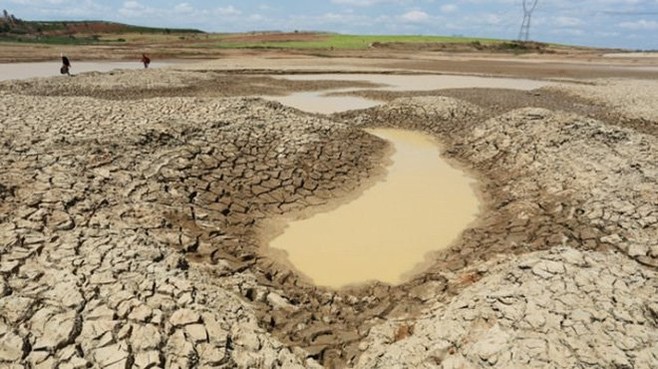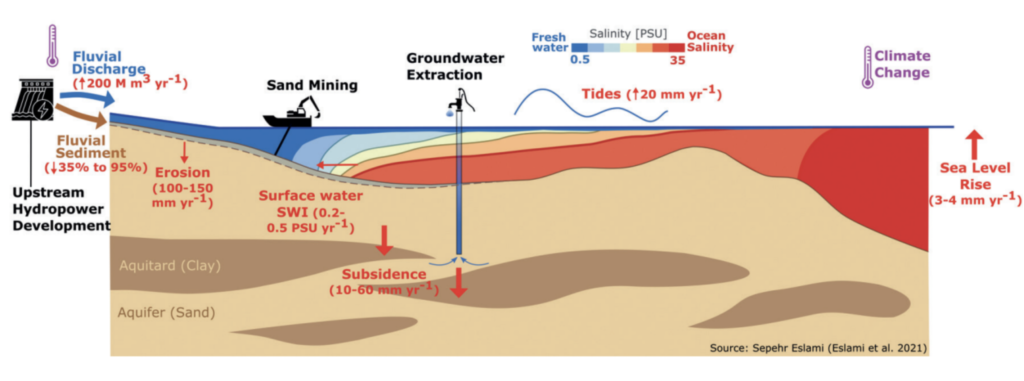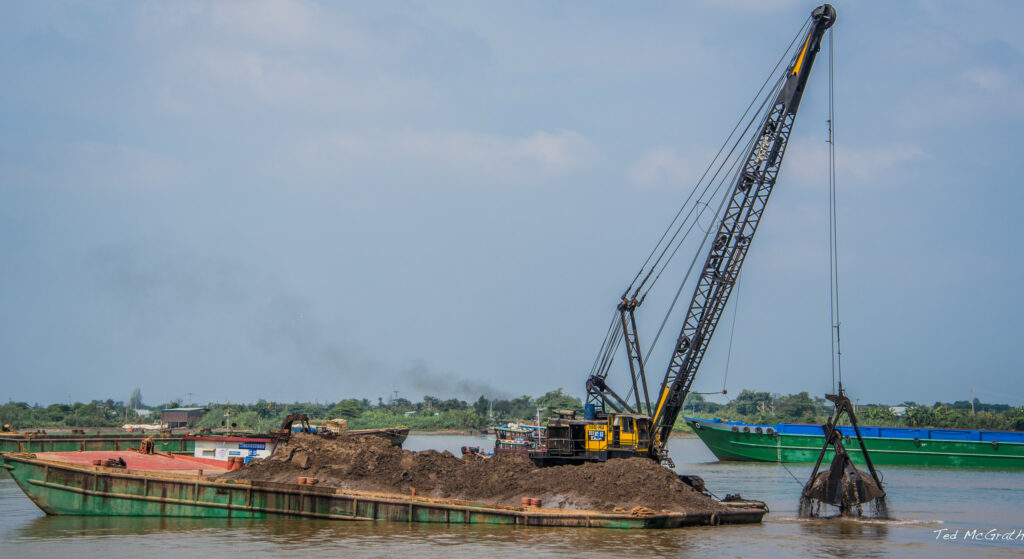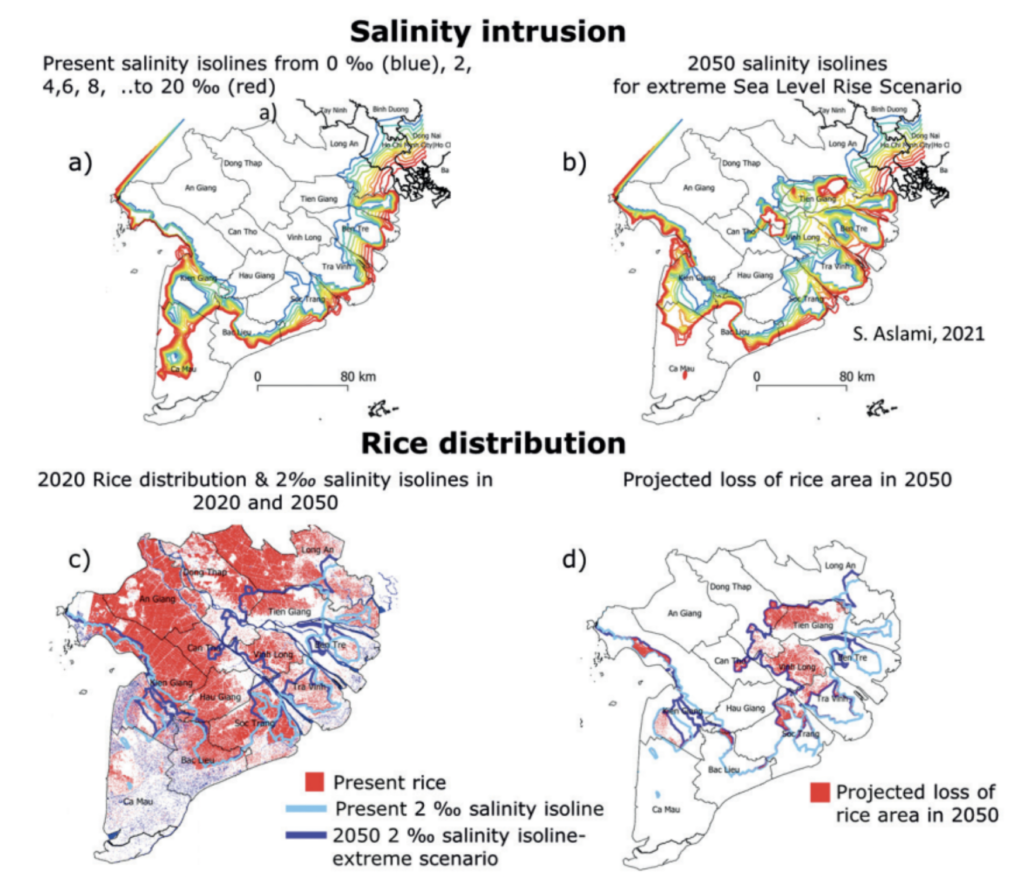The New Normal: Mekong Delta faces droughts and saltwater intrusion
1. The Situation
Vietnam’s Mekong Delta is the third-largest delta on Earth and home to nearly 18 million people, whose livelihoods rely mainly on agricultural and aquacultural production. Considered the “Rice Bowl” of Vietnam, the Delta supports more than half of the country’s total rice production and 95% of rice exports, contributing to Vietnam’s position as the world’s third-largest rice exporter. The region also produces 70% of the country’s fruits and more than 60% of the country’s seafood exports.1
The region has recently faced the most severe periods of drought and saline water intrusion in the last 100 years—notably in 2015–2016 and even more devastatingly in 2019–2020. Dry season droughts have become increasingly severe year over year, forcing the Government to declare a state of emergency and issue a call for international support. Increased salinity hit 10 out of 13 provinces in the Mekong Delta during the 2019 and 2020 seasons, affecting 58,000 hectares (ha) of rice, 6,650 ha of fruit trees, 1,241 ha of vegetables, and 8,715 ha of aquaculture. Up to 96,000 households or 430,000 people faced a shortage of daily use water.2In addition, a thousand spots of subsidence have been recorded around the Delta, causing substantial damage to roads and houses.3

Mekong delta lacking of water for domestic use and produciton. Photo from moitruongvadothi.vn.
The impact of these issues is most severe for poor households, which suffer from water shortages and loss of income as production interruptions reduce the demand for labor. In addition, the risks posed by hygiene issues and water-borne disease increase—especially among the poor, women, and girls—when rainfall is deficient in the dry season. On top of these challenges, the COVID-19 pandemic has put additional socio-economic pressure on vulnerable households already affected by drought and saltwater intrusion.
2. The Causes
Over the past three decades, the Mekong Delta has been subject to significant geophysical and environmental changes. The land is subsiding by an average of about 1 cm/year, with local maximums of up to 6 cm/year. At the same time, the tides are rising at a rate close to 2 cm/year, and salinity is increasing by approximately 0.2 – 0.5 PSU/year. Rapid elevation loss is strongly linked to groundwater extraction. In contrast, rising tides and increased saline water intrusion are linked to a rapid erosion of riverbeds, at rates of 10 – 15 cm/year, a result of reduced sediment flowing into the Delta due to downstream sand mining and upstream impoundments.4
According to experts, the Mekong Delta’s recent record of early, deep, and prolonged drought is driven by three main factors: (i) climate change; (ii) upstream factors including low reserves in the Tonle Sap and the extremely low flow of the Mekong River caused by decades of dam development on mainstream rivers from China to Cambodia;5 and (iii) downstream factors that create erosion and subsidence, including groundwater over-extraction serving intensive agriculture practices in the Delta, a network of dikes preventing natural flooding for agriculture protection, and excessive sand mining.
Figure 1: Climatic and anthropogenic drivers of change in the Mekong delta6

An imaginary cross-profile of the Mekong delta through its estuarine system, the observed rates of trends (red) and the primary anthropogenic (black) drivers along with climate change (purple).
Climate change
The Mekong Delta has an extraordinarily flat and low-elevation delta plain, sitting less than two meters above local mean sea level, with an average elevation of just 80 cm. Therefore, the Delta is highly vulnerable to even relatively small changes in sea level or vertical land motion caused by climate change. About 30% of the Delta could find itself at elevations below sea level with a relative sea level rise of just 50 cm.7
Climate change also impacts rainfall distribution during the wet season, which increases the frequency and intensity of large storms and inundation in the upstream provinces of the Mekong Delta. At the same time, climate change prolongs the dry season, which reduces the water volume flowing from the mainstream of the Mekong River into the Delta, leading to a lack of fresh water and increased salinity.8A projection for several critical provinces in the Delta showed that, by 2100, rainfall will increase in rainy months by 25%, and decrease in dry months by 30 – 35%. As a result, the dry seasons will get drier, and rainfall in the rainy season will be more intense.9
In addition, changes in temperature increase the likelihood and impact of diseases and environmental pollution, which directly affect people’s health and aquaculture. Rising temperatures have already been recorded at all stations in the Delta, and are projected to increase by 1.8°C by mid-century and up to 3.7°C by the end of the century.10
Hydropower dams
In the upper Mekong basin, China has constructed 11 hydropower dams, of which two are large storage dams. Another 11 dams, each with a production capacity of over 100 MW, are being planned or constructed. In the lower Mekong basin, 11 mainstream dams are in various stages of planning and completion in Laos and Cambodia,11many of which involve Chinese investment. While these dams normally do not consume water, when the water flow is deficient (such as during a drought), they must tap into reservoirs on tributaries to generate power. And, while each dam on the mainstream retains water for just 3-18 days, it takes much longer for water to ultimately pass through the full series of dams before reaching its destination in the Delta.12Moreover, during the annual flood season, these dams hold back water, sediments, and fish that would otherwise move downstream.13
Map 1: Hydro power dam projects in the Mekong basin
Ground water extraction and sand mining
In the Delta area, agriculture production has been widely pushed to support food security and rice exports over the past three decades. Farmers have increased their annual crop production from two to three, exploiting all soil nutrition. Dykes and other irrigation systems have been built to control water flow, preventing natural flooding, and sending sediments—which are crucial to rebuilding soil health—from upstream to the sea.14At the same time, watering rice and fruit trees requires the extraction of a massive amount of groundwater, leading to rapid elevation loss. According to the Ministry of Natural Resources and Environment, the Mekong Delta currently has 7,733 wells with a capacity of more than 10m3/day.15
Combined with upstream dams cutting off sediment flow, local sand mining has starved Delta provinces of sediment. These two factors are responsible for the degradation of the Delta’s banks, resulting in roads and homes being washed away during times of high water flow.16

Sand mining in Mekong Delta. Photo by Ted McGrath, via Flickr Licenced by CC BY-NC-SA 2.0.
Hydropower dams, excessive sand mining, and over-extraction of groundwater pose the most significant threats in the coming three decades. However, climate change impacts, such as changes in river discharge and an increased frequency of extreme weather events will likely become the dominant threats in the second half of the century.17
3. The Impacts
Prolonged drought and saltwater intrusion have hurt people’s livelihoods and assets, making it difficult for affected households to bounce back and recover.
Agriculture
Cultivated land, soil quality, and crop yields in the Mekong Delta are diminishing due to drought and increased salinity. Pests and diseases also develop, multiply, and increase in pathogenicity, resulting in greater disease transmission risk among animals, and in turn affecting both crops and livestock. Coastal economies and fishing and aquaculture activities are also seriously affected as sea-level rise penetrates deeper into the continent.18
Projections show that nearly 10% of the existing rice growing area during the dry season could be lost by 2050 due to saline intrusion alone. Sea level rise poses an even greater threat to rice-growing areas in the Delta, with the loss due to inundation projected to be between 22% and 34%, and up to 58% in case of extreme global sea level rise. In addition, rising temperatures, persistent drought, and increased salinity (0.5 to 2‰) is forecast to reduce rice yield in the remaining non-submerged areas by 35 – 45%.19
Figure 2: Present and Projected Saline Intrusion and Rice cultivation in the Mekong Delta20

Note: Impact of salinity intrusion on rice area. a) Contour lines of the present time surface water salinity from 0 ‰ the most inland to 2, 4, 6 ..20 ‰; b) Contour lines from the projection for 2050 under scenarios RCP8.5 (river discharge), with extreme scenarios for subsidence, riverbed level changes and sea level rise (+60 cm); c) Winter-Spring rice map overlaid with contour lines for 2 ‰ salinity for the present time (light blue) and for 2050 (dark blue); d) rice area (in red) which will be less suitable for rice cultivation in 2050.
Industrial processing and manufacturing sectors
Ultimately, raw materials from agricultural, aquaculture, and other products supplied to the food processing, textile, and garment industries will significantly decline due to a lack of access to material extraction areas in the Mekong Delta provinces.21
Health and mortality
Climate disasters indirectly affect health due to environmental pollution, malnutrition, and disease, in addition to socio-economic, planning, employment, and income disruptions. The most vulnerable will be poor farmers, ethnic minorities in rural areas, the elderly, children, and women. Moreover, extreme weather phenomena will become more frequent, with women’s work—which commonly involves water collecting and agricultural activities—particularly becoming harder.22
Disaster-induced migration
When disaster adversely affects households’ economic activities—reducing income, undermining the food supply, reducing cultivated land area, or making some regions uninhabitable—poor people in coastal and rural areas are forced to leave their homes and communities behind to migrate to the cities or other places. Over the last ten years around 1.7 million people have already migrated out of the Mekong Delta’s vast expanse of fields, rivers, and canals. The rate of migration away from Mekong Delta provinces is more than double the national average and even higher in its most climate-vulnerable areas.23
4. The Adaption
Government and citizens have searched for drastic measures to cope with and prepare for the annual dry season in the Mekong Delta.
At the regional level, Resolution 120 of 2017 acknowledges the negative impacts of high-intensity economic growth of the region. It aims to sustainably develop the Mekong Delta in adaptation to climate change—with goals for 2050 and a vision through 2100—and calls for comprehensive and synchronous solutions, with an emphasis on international cooperation. At the national level, the Ministry of Agriculture and Rural Development (MARD) released a national plan for adaptation to climate change in 2021, which covers the period 2021–2030, with a vision for 2050. This national plan focuses on strengthening state management of climate change and promoting the integration of climate change adaptation into the strategic system and regional planning.24MARD also published its intermediate and long term solution to the Mekong Delta’s drought and saltwater intrusion challenges.25
In particular, the government is building large reservoirs,26drilling wells, extending pipelines from concentrated water plants, installing public water hoses, and investing in public taps where applicable.27Given the tendency of farmers to convert land use purposes spontaneously, land conversion has been managed using an administrative tool to fit with the government’s plan. There is also an effort to convince people to adopt climate change-adapted farming systems, such as two rice seasons and one vegetable season, or two rice seasons and one rice-shrimp season in vulnerable areas with support on shrimp varieties and technical transfers. Other measures include planting the winter-spring rice crop a month early; instructing farmers not to grow their rice in areas that are likely to be affected by saline intrusion; and reducing winter-spring rice area to save water.28
On the individual level, many adaptation solutions in aquaculture and agriculture farming systems are being made in line with temperature increases and rainfall decreases. For example, agricultural structures are being transformed from a single-crop specialization in rice production towards a multiple-crop model with a rotation of rice and other crops, such as vegetables and corn.29Moreover, farmers have applied advanced water-saving irrigation solutions for shallow crops, industrial and fruit trees with high commercial and economic value. Farmers have also started shifting to more diversified crops and cultivation methods, as some rice farmers are now planting fruits, vegetables, or flowers while others are converting to new methods of rice farming.30In coastal areas, people are storing rainwater and building freshwater settling tanks of plastic and cement,31which is an economical and effective solution to the issue of saline intrusion. And in aquaculture, farmers are applying advanced technology to minimize their dependence on natural factors by controlling the aquatic environment, as well as using roofs to control rainfall and temperature.32
5. Conclusion
The Mekong Delta’s recent drought and saltwater intrusion provide a guide to what could become the “new normal” and highlight the need to take action. No matter how much is done to adapt, the root causes of the issues must be addressed, or the situation will only continue to worsen.
Given that 90% of the Mekong River basin relies on foreign flows, the Delta is strongly influenced by the policies of water governance enacted by authorities throughout the whole Mekong watershed. However, current regional structures of governance and systems of management for trans-boundary resources in the Mekong region are complex—involving a web of organizations and a variety of partners both inside and outside the region—making the situation challenging to address in a timely and coordinated manner. With the Delta facing losses and damages beyond its resilience and adaptive capacity, the Government should move diplomatically to reduce the negative impacts caused by upstream activities and take strong measures to end the overexploitation of sand and groundwater.33Sharing and managing risks must be considered at all grassroots, national, and international levels—because the window of opportunity for mitigation and adaptation is closing fast.34
References
- 1. Government of Vietnam. 2017. Resolution No.120 on sustainable development of Mekong delta in adaptation to climate change. Accessed December 28, 2021.
- 2. Vietnam Disaster Management Authority. 2020. Overcoming the saltiest drought in history, lessons for the present and future. Accessed December 28, 2021.
- 3. Hochiminh city Police. 2020. Severe drought and salinity in the Mekong Delta: Landslides and subsidence occur everywhere. Accessed December 28, 2021.
- 4. Espagne E. (ed.), T. Ngo-Duc, M-H. Nguyen, E. Pannier, M-N. Woillez, et.al. 2021. “Climate change in Viet Nam: Impacts and adaptation. A COP26 assessment report of the GEMMES Viet Nam project.” Assessed December 28, 2021.
- 5. Tatarski, M. 2021. “Vietnam struggles to find solutions for extreme dry seasons in Mekong delta”. The Third Pole. Accessed December 28, 2021.
- 6. Espagne E. (ed.), T. Ngo-Duc, M-H. Nguyen, E. Pannier, M-N. Woillez, et.al. 2021. “Climate change in Viet Nam: Impacts and adaptation. A COP26 assessment report of the GEMMES Viet Nam project.” Assessed December 28, 2021.
- 7. Ibid.
- 8. Nguyen, H.T. & P. Degenhardt. N.D. “The Many Climate Challenges Facing the Mekong Delta.” Rosa Luxemburg Stiftung. Accessed February 25, 2022.
- 9. Mackay, P. & M. Russell. 2011. “Socialist Republic of Viet Nam: Climate Change Impact and Adaptation Study in the Mekong Delta.” Asian Development Bank. Accessed February 25, 2022.
- 10. Espagne E. (ed.), T. Ngo-Duc, M-H. Nguyen, E. Pannier, M-N. Woillez, et.al. 2021. “Climate change in Viet Nam: Impacts and adaptation. A COP26 assessment report of the GEMMES Viet Nam project.” Assessed December 28, 2021.
- 11. Mekong River Commission for Sustainable Development. Hydropower. Accessed February 25, 2022.
- 12. Tatarski, M. 2021. “Vietnam struggles to find solutions for extreme dry seasons in Mekong delta”. The Third Pole. Accessed December 28, 2021.
- 13. Ngh, M. 2019. “Vietnam needs to act in Mekong Delta as land sinking, seas rising: Experts”. VN Express International. Accessed December 28, 2021.
- 14. Tatarski, M. 2021. “Vietnam struggles to find solutions for extreme dry seasons in Mekong delta”. The Third Pole. Accessed December 28, 2021.
- 15. Tung, T. 2021. “Riverbank erosion, coastal erosion—a burning problem of the Mekong Delta.” Natural resource and Environment News. Accessed February 25, 2022.
- 16. Thuy, T. 2021. “Mekong Delta in crisis due to exploitation of sand and waterbanks”. PIME Asia News. Accessed February 25, 2022.
- 17. Espagne E. (ed.), T. Ngo-Duc, M-H. Nguyen, E. Pannier, M-N. Woillez, et.al. 2021. “Climate change in Viet Nam: Impacts and adaptation. A COP26 assessment report of the GEMMES Viet Nam project.” Assessed December 28, 2021.
- 18. UN Women. 2021. “The State of Gender Equality and Climate Change in Viet Nam.” Accessed December 2021.
- 19. Espagne E. (ed.), T. Ngo-Duc, M-H. Nguyen, E. Pannier, M-N. Woillez, et.al. 2021. “Climate change in Viet Nam: Impacts and adaptation. A COP26 assessment report of the GEMMES Viet Nam project.” Assessed December 28, 2021.
- 20. Ibid.
- 21. UN Women. 2021. “The State of Gender Equality and Climate Change in Viet Nam.” Accessed December 2021.
- 22. Ibid.
- 23. The Conversation. 2018. “Climate change is triggering a migrant crisis in Vietnam”. Accessed December 28, 2021.
- 24. Mekong Delta Business Platform. “Trends and Developments in the Mekong Delta.” Accessed December 28, 2021.
- 25. Vietnam Disaster Management Authority. 2020. “MARD Report on the Drought and Saltwater Intrusion in the Mekong River Delta.” Accessed December 28, 2021.
- 26. Nam, H. 2020. “Province to build largest reservoir in Mekong Delta to cope with droughts, salinity.” VN Express International. Accessed February 25, 2022.
- 27. Government of Vietnam. 2020. “MARD Report on the Drought and Saltwater Intrusion in the Mekong River Delta.” Accessed December 28, 2021.
- 28. Osborne, Z. 2020. “The great salt drought desiccating Vietnam’s Mekong Delta”. Al Jazeera. Accessed February 25, 2022.
- 29. Bong, B.B., Bo, N.V., Son, N.H., Tung, L.T., et.al. 2018. “Adaptation Options for Rice-Based Cropping Systems in Climate Risk-Prone Provinces in the Mekong River Delta: An Assessment Report”. CCAFS Working Paper No. 245. (Wageningen, Netherlands: CGIAR Research Program on Climate Change, Agriculture and Food Security–CCAFS). Accessed February 25, 2022.
- 30. Osborne, Z. 2020. “The great salt drought desiccating Vietnam’s Mekong Delta”. Al Jazeera. Accessed February 25, 2022.
- 31. Nam, H. 2020. “Province to build largest reservoir in Mekong Delta to cope with droughts, salinity.” VN Express International. Accessed February 25, 2022.
- 32. Pongthanapanich, T., K.A.T. Nguyen, & C.M. Jolly.2019. “Risk management practices of small intensive shrimp farmers in the Mekong Delta of Viet Nam.” FAO Fisheries and Aquaculture, Circular (1194), p. 30. Accessed February 25, 2022.
- 33. Nga, M. 2019. “Vietnam needs to act in Mekong Delta as land sinking, seas rising: Experts.” VN Express International. Accessed February 25, 2022.
- 34. Espagne E. (ed.), T. Ngo-Duc, M-H. Nguyen, E. Pannier, M-N. Woillez, et.al. 2021. “Climate change in Viet Nam: Impacts and adaptation. A COP26 assessment report of the GEMMES Viet Nam project.” Assessed December 28, 2021.

